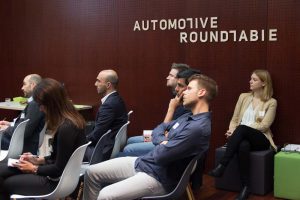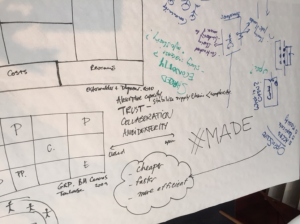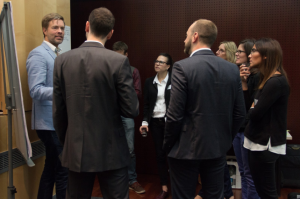Making sense of our connected world

The evolution of the open source community and the disruption of the hardware industry
Open source hardware is not merely a buzzword any more. The increase of velocity in building innovative hardware solutions through platforms and their co-creators did not go unnoticed. In fact, open source hardware has moved into the centre of the attention of many established firms. Additive manufacturing as applied by Local Motors has led many large automotive manufacturers to consider new approaches to fabricate their hardware products. In order to understand what can be learned from the open source movement, it is vital to acknowledge where open source is actually coming from. Therefore, we hosted a roundtable on chances and challenges through open source hardware innovation along the supply chain in September 2017. Our guests ranged from OEMs to suppliers to mobility startups and academia.
More about Disrupted! – The Automotive Roundtable

Bringing together OEMs, suppliers, startups, the ecosystem and academia to shape future business models.
Origins of the open movement
The open movement arose from open source software. Linux is just one example of this movement, which based on sharing codes openly in the community. This way, everyone could contribute but also profit from the resulting efforts. Today, Windows and other large corporations are some of the most important contributors to the open source software community.
Similarly, the maker movement lives from openly sharing. There is a huge culture around ‘making’ that is fostered by so-called maker spaces — open, digital work areas for makers, that provide tools and machinery, and allow for them to meet and to jointly work on their designs. Such an open sharing of knowledge, insights, and designs is further supported by the engagement in digital and virtual communities all over the world.
Recent challenges for maker movements
Due to those open movements, traditional perceptions of ownership, licensing, or IP changed radically. Yet, with its increasing professionalization the movement has already seen various open systems close to use the ideas, concepts and designs for individual and business spezialisation (e.g. printing organs, etc.). Not surprisingly, their closing had a sour note and caused feelings of betrayal in the communities, which had trustfully shared knowledge and engaged in open platforms.
Openness fosters knowledge and accelerates innovation
In general, open communities present us with many advantages: They enable a sharing of knowledge and worldwide (technological) advancements through virtual communities of co-creators. Individual passion and engagement are core ingredients, and initiate innovative and radically new hardware products (e.g. Local Motors: RallyFighter, Olli bus). As our research on the topic matured, we came up with various questions:
- How can we foster open business models together with traditional industries?
- How can we create new knowledge jointly with open communities and closed industries?
- How can we capture value from openness?
Understanding the chances and challenges in the hardware industry
To answer those questions, the Alexander von Humboldt Institute for Internet and Society (HIIG) hosted the roundtable Disrupted! on 13 September 2017. During lively discussions with participants from the automotive industry, their suppliers, mobility startups, and academia, HIIG addressed the challenges around open innovation, open source, and disruptive business models. In cross-sectoral workshop sessions, open discussions, as well as input and collaboration formats, the participants jointly explored the future of co-creation in the mobility sectors, the effects of open innovation on the supply chain, and mobility business models.

Developing the pillars of strong partnerships between traditional and new players in the mobility industry.
Traditional industry players have a hard time to embrace open source innovation
There are various challenges for traditional firms in established industries when it comes to openness. The agreed on, traditional understanding of research and development (R&D) is that it happens in a closed, protected space. However, to profit from and enable open innovation, we need to initiate open processes, structures, and strategies. This way, we can stop organizations’ remaining protectiveness of closed business models and help them to acknowledge the advantages of value sharing through openness, e.g., regarding accelerated R&D processes, or innovative product solutions.
Trends such as e-mobility and autonomous driving, together with cross-sectoral digitalization and a globalized makers culture challenge established markets and peer groups. Open innovation can, however, be a source of creative innovation development. Openness along the supply chain enables companies to use their excess capacities better — up to a point, where the supply chain of the future could be decentralized and autonomous, as suggested by Dr. Alev Kirazli, project manager autonomous transport and open innovation at Volkswagen Group, in her video statement.
https://youtu.be/OV8D_hnpD_I?list=PLXMgjqxV5HdLIgVchxCCkbOUq5Dw8pq_v
Challenge established company structures
Prospects like new insights, fast solutions, savings of resources, and flexibility motivate large organizations to look out for functioning and possibly more open business models. However, the creation of trust and transparency on all levels has shown to be a crucial step for companies in order to actually dare to interact on equal levels with smaller, external players. In that, interaction might occur externally between corporates, suppliers and startups, as well as internally between various layers of the company. Use cases help to illustrate how successful setups nurture the knowledge flow into various directions — a point underlined by Philip Meier, Open Innovation Manager at Volkswagen Group. Those illustrations also encourage companies to build, maintain, and develop platforms as a playground for multiple partners with distinct experiences and capabilities. Furthermore, having a partner in academia directly webbed into an open innovation project can help to frame an impartial space of interaction. This might even support agile mindsets in regards to both companionships and business model opportunities.
Disruption on all levels
The aforementioned trends of digitalization and autonomy, embedded in an highly individualised on-demand sharing economy, highlight that the automotive industry is at the verge of a radical disruption along its entire value and supply chain. The focus of the industry will no longer be on the “car” and its manufacturing. Instead, the services around the car will increasingly gain importance. Through linking those services in mobility applications, the supply chains will not only gradually open but also interlink more and more. This leaves only a small part of the value chain of the future to manufacturing. Especially small and medium-sized companies benefit from the new levels off interaction and the access to projects and problems, as the innovation consultant Lutz Göcke from SWAN Ventures suggests.
Taking baby steps to foster open source innovation in traditional enterprises
We need new key performance indicators that reflect openness (e.g. the quantity of co-creators engaged in a project). And we need egalitarian structures, which acknowledge the co-creators’ efforts to willingly contribute to the community. With the opportunity to grow at the core of each co-creator’s participation, it is crucial to support knowledge flows and to encourage relations to prospective partners, colleagues, and customers. By that, the learnings from each actor can be translated into the project and into the DNA of the central firm. Lastly, we need to appreciate that open source innovation concerns a lot more stakeholders than the focal firm and its immediate internal and external stakeholders. It even can open up closed processes to younger generations and minority groups, and thus lead to growth and common wealth for entire societies and future generations.

Disupted! The Automotive Roundtable was compiled of input sessions, open discussions, workshops and collaborative formats in a cross-industry setting.
Embrace the challenge of open source innovation and design future societies
In sum, open source innovation is the pathway to foster knowledge openly in virtual communities. It is hence a reflection of user behaviour, which we see already in younger generations. Traditional industries and their R&D can crucially benefit from opening up. They gain the chance to gather user feedback early on, to accelerate their innovations, and to develop digital products, services, and business models, which they would not even have foreseen otherwise.
Traditional players of the automotive industry: Embrace the chances of open source and become shapers of the workplace of the future!
| We would like to thank the following actors for sharing their input: Volkswagen Group, Schnellecke, General Interfaces, BGW, Fraunhofer IPA, Fraunhofer IAO, Swan Ventures, mapegy, re2you, BSH Hausgeräte, CERAG, Roland Berger, Kreatize, Local Motors. |
| This post represents the view of the author and does not necessarily represent the view of the institute itself. For more information about the topics of these articles and associated research projects, please contact info@hiig.de. |
This post represents the view of the author and does not necessarily represent the view of the institute itself. For more information about the topics of these articles and associated research projects, please contact info@hiig.de.

You will receive our latest blog articles once a month in a newsletter.
Digital future of the workplace
Polished yet impersonal: The unintended consequences of writing your emails with AI
AI-written emails can save workers time and improve clarity – but are we losing connection, nuance, and communication skills in the process?
AI at the microphone: The voice of the future?
From synthesising voices and generating entire episodes, AI is transforming digital audio. Explore the opportunities and challenges of AI at the microphone.
Do Community Notes have a party preference?
This article explores whether Community Notes effectively combat disinformation or mirror political biases, analysing distribution and rating patterns.





